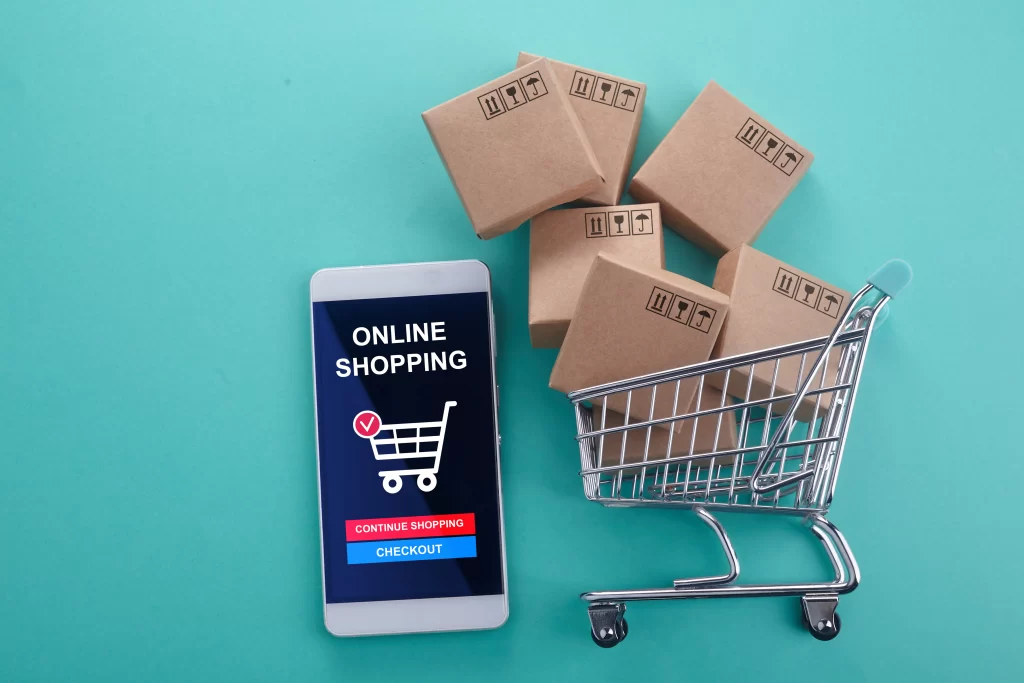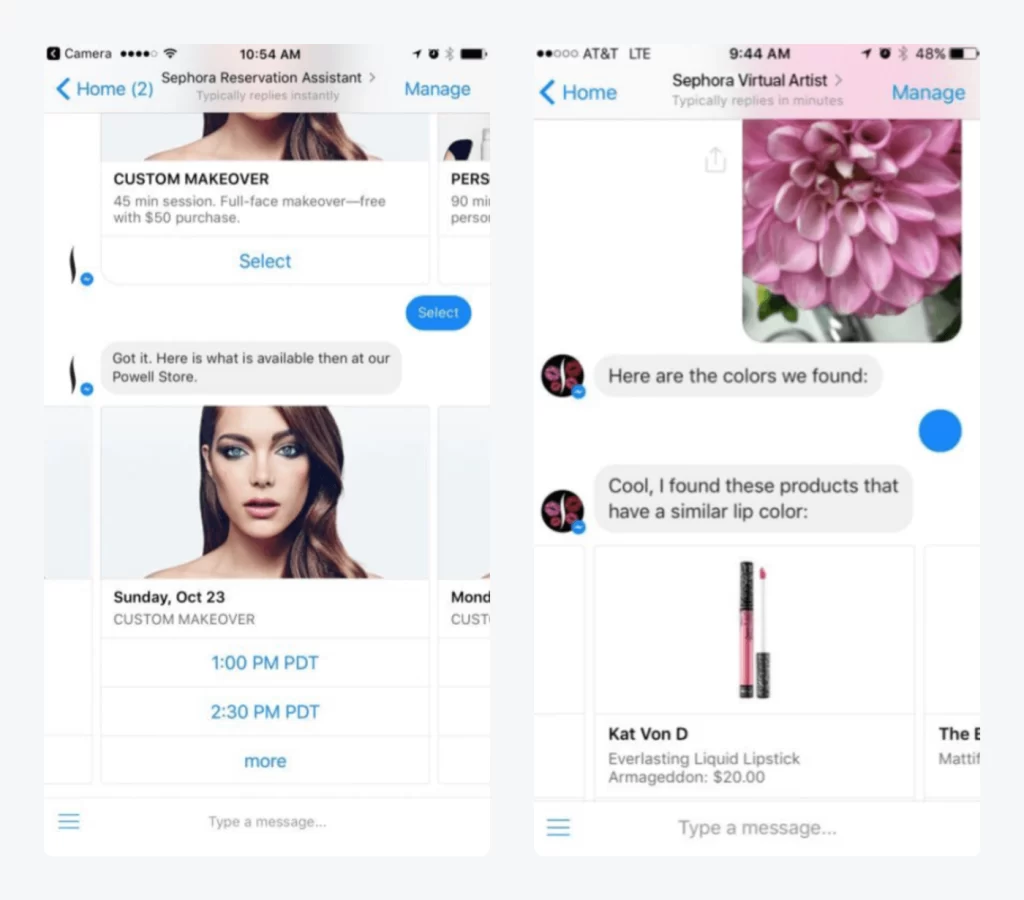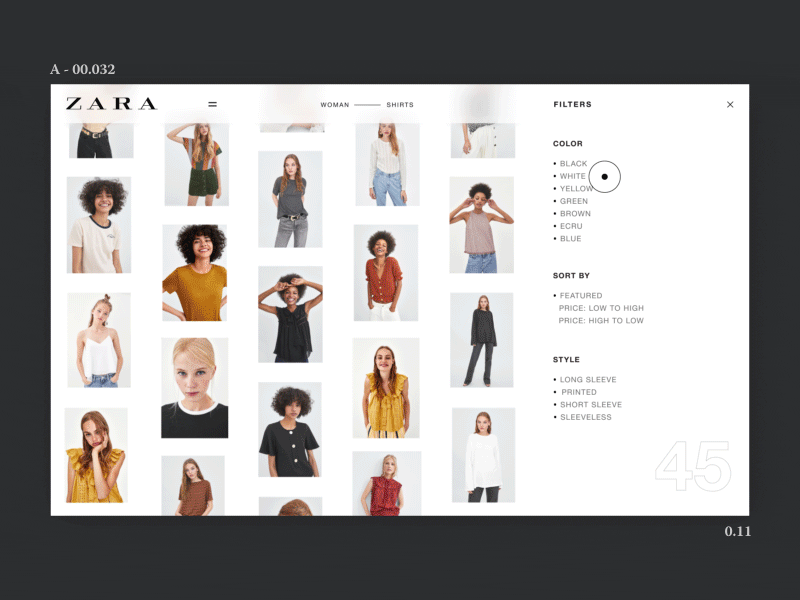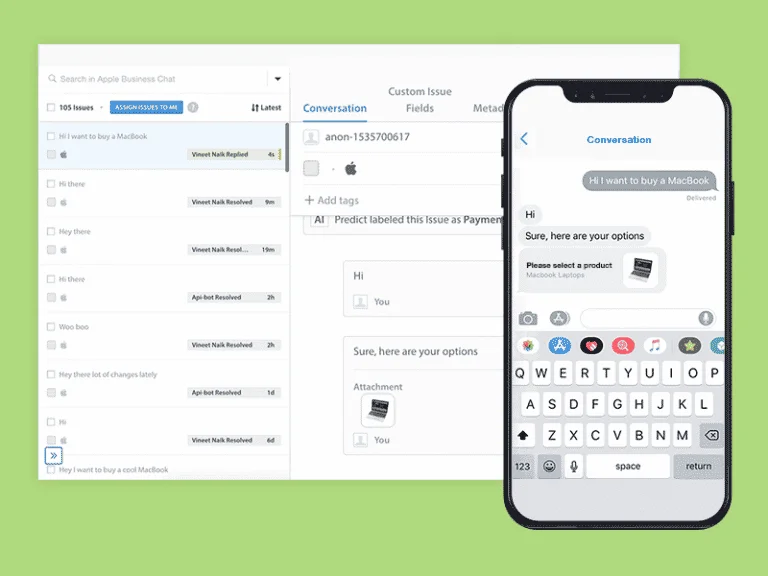E-commerce web design trends refer to the design strategies that businesses implement on their online shopping websites and mobile apps.
These trends not only give the store a fresh look but also make it easier to navigate, engage customers, and boost sales.
Every day, users expect more from their online experiences.
So, it’s not about making things easy anymore; it’s about making online shopping feel like shopping in a real store.
To meet these expectations, businesses are leveraging all available technology.
In this blog, we’ll explore the top e-commerce web design trends for 2024.
We’ll discuss how these trends can enhance online shopping experiences for customers.
Top 23 E-commerce Web Design Trends to Watch in 2024

E-commerce websites are undergoing tremendous changes, thanks to the evolving trends.
From how we explore products to making payments for our purchases, everything is getting better and smoother.
Let’s dive into the e-commerce web design trends that will be in use this year, making our digital shopping more engaging and more convenient than ever before.
1. Experimental Navigation
This e-commerce web design trend is all about transforming the shopping experience from a simple click-and-buy process to an interactive journey.
Imagine virtually walking through a store or playing with 3D product models right from your couch.
This innovative approach not only makes the store stand out but also showcases the brand’s tech-savviness and creativity.
It encourages users to spend more time exploring the site, which ultimately leads to more purchases.
2. Content-loading Methodologies
These methodologies, which are particularly important for e-commerce platforms, can significantly impact customer satisfaction and sales by providing a smooth and efficient user experience.
In 2024, smart content-loading techniques are set to become game-changers in online shop design.
Techniques like lazy loading and asynchronous loading speed up page loads by prioritizing the display of crucial elements like product images and descriptions.
This not only enhances the user experience by reducing wait times but also keeps customers on the site longer, thereby reducing bounce rates and potentially increasing sales.
3. Scrolling Animations
This feature involves using animations that activate as users scroll through the site.
As product images smoothly transition and reveal more details, users are encouraged to explore further.
But it’s not just about visuals – these animations can also enhance interactive elements like buttons, adding a touch of excitement to the shopping journey and transforming e-commerce websites into visually stunning spaces.
4. Immersive Web Animations
Immersive web animations can greatly enhance the user experience on e-commerce websites by creating a more engaging and interactive shopping environment.
Here are a few ways immersive animations can help:
Showcase products in a more dynamic way: Animations can be used to create 360-degree product views, product demonstrations, and even interactive features that allow customers to explore products in more detail. This can increase customer confidence and lead to more sales.
Improve navigation and user experience: Animations can be used to create more intuitive and engaging navigation menus, calls to action, and other website elements. This can make it easier for customers to find what they are looking for and complete their purchases.
Tell your brand story and create a more emotional connection with customers: Animations can be used to create short videos or interactive elements that tell your brand story and showcase the value proposition of your products. This can help you build trust with customers and create a more memorable shopping experience.
Overall, immersive web animations can be a powerful tool for e-commerce websites to improve customer engagement, increase sales, and create a more competitive online presence.
5. Animated Product Reveals
It’s not just about showing a product from different angles, but also about revealing hidden features, demonstrating how the product works, and even telling a story.
This can make the shopping experience more engaging and help customers make informed decisions.
It’s like having a salesperson in the room with you, pointing out the key features and benefits of the product.
6. Attractive Product Visuals
Eye-catching product visuals play a crucial role in e-commerce design.
The ability to zoom in, view products from every angle, and even try things virtually brings the store right to the user’s screen.
When e-commerce sites focus on creating visually appealing content, it not only makes customers happier but also encourages them to explore more, potentially boosting sales.
7. Minimalistic Design for Products
This unique e-commerce design trend is about simplicity and functionality.
With a clean layout and short, punchy product descriptions, the focus is on the products.
The use of few colors and lots of white space creates a calm, distraction-free environment that allows each product to shine.
This sophisticated and clear design helps customers make quick decisions and provides a more elegant shopping experience.
8. Centered Navigation Menus
This improves the mobile shopping experience by making the navigation menu more accessible.
By placing the menu in the center of the screen, it’s easy to reach with one hand.
This can make browsing and buying on a mobile device more convenient and user-friendly.
It’s like having the controls right at your fingertips, making it easy to navigate the site and find what you’re looking for.
9. AI Chatbot Feature
AI chatbots are revolutionizing customer interaction in e-commerce.
AI analyzes user behavior to provide personalized product recommendations, enhancing the overall shopping experience.
Chatbots, powered by AI, provide instant answers to questions and assist customers in making decisions.
They can even track orders and suggest alternatives, making the purchasing process seamless.
These features make e-commerce websites more dynamic and customer-friendly, leading to increased sales and brand loyalty.
10. Page Transition
This replaces abrupt page jumps with smooth animations, creating a sense of continuity.
Imagine transitioning from selecting a product to checking out with a pleasing animation – it’s like flipping through a beautifully crafted catalog.
This technique reduces loading delays, making browsing more enjoyable.
By incorporating these transitions, e-commerce sites enhance their aesthetics and improve user satisfaction.
11. Immersive Branding Experiences
With AR, AI, and VR, shopping becomes an immersive experience.
Customers can try on clothes virtually, see how furniture would look in their home, or explore a store as if they were physically there.
This not only enhances the shopping experience, but also strengthens the connection between the brand and the customer.
It’s like stepping into a virtual store, where you can interact with the products and the brand in a whole new way.
12. Unconventional Page Filters
This e-commerce design trend is about reimagining the way customers search for products.
Instead of traditional dropdown menus, e-commerce sites are introducing innovative filters like sliders, color wheels, or even interactive maps.
These creative filters not only make searching fun but also demonstrate the site’s commitment to innovation.
By offering these unique filters, e-commerce sites provide customers with a novel and easy way to discover items, enhancing the browsing experience and potentially leading to unplanned purchases.
13. Elegant Typography and Beautiful Colors
The combination of stylish fonts and stunning colors can significantly impact an e-commerce websites appearance.
Clear and attractive fonts facilitate easy comprehension of product details.
Meanwhile, the strategic use of colors can evoke emotions and highlight important elements like ‘buy now’ buttons.
By employing elegant typography and colors, e-commerce sites create an eye-catching and consistent look that grabs attention and builds trust.
14. Multidirectional Layouts
This trend involves breaking away from traditional grid layouts and experimenting with different arrangements.
Imagine products displayed diagonally or categories arranged in a circular pattern – this is not your typical left-to-right scroll.
It’s more like exploring a virtual shop from multiple directions.
By adopting these multidirectional designs, e-commerce websites distinguish themselves, grab attention, and make browsing more interactive and memorable.
15. Storytelling for Product Page
Storytelling goes beyond listing product features – it’s about creating a narrative around each item.
Whether it’s sharing the product’s origin, how it’s made, or customer experiences, storytelling fosters a connection between the customer and the product.
By incorporating stories, e-commerce websites can make customers feel more engaged, encouraging them to return. Storytelling is not just about selling – it’s about forging a relationship with the brand.
16. Neutral & Pastel Colors
This trend involves using soft, muted colors like greens, blues, or greys to create a peaceful vibe on the website.
These colors provide a calm backdrop that allows the products and information to stand out.
By using these gentle hues, e-commerce sites present a modern and appealing look that encourages users to spend more time browsing and builds trust in the site.
17. Neo-brutalism and Whimsigothic Visuals
These design styles break away from traditional aesthetics to create unique and engaging visual experiences.
Neo-brutalism is raw and unpolished, often using monochromatic color schemes and bold typography.
Whimsigothic visuals, on the other hand, combine whimsical elements with gothic aesthetics for a quirky and distinctive look.
It’s like stepping into a different world, where the usual rules of design don’t apply.
18. Animated Navigation and Chunky Fonts with Saturated Colors
These design elements can make an e-commerce website more visually appealing and user-friendly.
Animated navigation can guide customers through the site, while chunky fonts and saturated colors can highlight key information and calls to action.
This can make the shopping experience more enjoyable and efficient.
It’s like having a tour guide who can show you the way and point out the important sights.
19. Conversational Interfaces
Using chatbots to assist customers while they shop.
Imagine having a virtual helper that’s there in real-time, answering your questions and even suggesting products you might like.
By incorporating these chat interfaces, e-commerce websites make shopping more engaging and personal.
The idea is to make online shopping feel more like a conversation with a helpful store assistant, making it easier to find what you want and adding a personal touch to the online shopping experience.
20. Asymmetrical Layouts
Asymmetrical layouts offer a fresh and engaging design.
They can draw attention to specific content, create a sense of dynamism, and give a site a distinctive look.
This can make an e-commerce site stand out and leave a lasting impression on customers.
It’s like exploring a new city, where the unexpected and the unusual can catch your eye and make your journey more interesting.
21. Microinteractions and Animations
It is like incorporating small, subtle animations and interactions that enhance the user experience.
Imagine buttons that change color when you hover over them or product images that zoom in when clicked.
These microinteractions not only make the website feel alive and engaging but also provide feedback and make the site easier to use.
By adding these cool touches, e-commerce sites can grab attention, improve the overall design, and make the browsing experience smoother and more enjoyable.
22. Frictionless Checkout
Imagine a checkout process where you have just one page with minimal fields to fill in – no unnecessary steps.
The site even remembers your payment details and auto-fills your address – how convenient is that?
This e-commerce design trend is all about making the checkout process quick and stress-free, similar to being in a super-efficient cashier’s line.
The integration of reliable payment gateways is also important here, as it ensures secure transactions, thereby building customer trust.
When e-commerce websites prioritize the frictionless checkout process, it results in fewer abandoned carts and happier customers.
The goal is to simplify the final steps of the shopping journey, ensuring customers end their shopping trip on a high note.
23. Voice Search and Shopping

This means integrating voice technology into e-commerce websites, allowing users to search for products and make purchases using voice commands.
Picture this: you ask for a product out loud, and the site pops up with options – totally hands-free and super convenient.
You can even use your voice to add items to your cart and confirm your order, making the shopping process quick and simple.
By adopting voice technology, e-commerce sites can cater to tech-savvy customers, enhance the shopping experience, and stay ahead in the competitive online shopping world.
Best Practices for Designing an E-commerce Website
When you step into e-commerce, competition is tough.
Not just local brands but also big international players like Amazon are in the game.
To stand out, focusing on every little detail of your website is a must.
Whether you’re starting fresh or sprucing up an old site, these tips matter.
Let’s look at some of the best practices for designing an e-commerce website that can help in the process:
1. User Experience Design
Set your e-commerce apart by making buyers feel connected to your products.
Avoid tricky navigation that might annoy customers. Instead, create clear sections, a smart search bar, and easy filters to help people find stuff fast.
Make shopping a breeze, letting folks quickly grab what they want and discover more without any fuss.
2. Fast Loading Speed
Speed up your page loads, aiming for under 3 seconds, especially on product pages and checkout.
Faster pages mean fewer people leaving your site and more people buying stuff.
3. Accessibility
Make your website more accessible by going beyond just text and colours!
Add features like text that can be zoomed in, captions for videos, and links to skip navigation.
When you design forms, think about making them easy to use for everyone, and provide alt text for all your images to cater to people with different abilities.
4. Intuitive Navigation
Make your website easy to navigate by having a well-organized menu.
Use categories that drop down and show subcategories, a really good search bar, and filters for products that everyone can use easily.
Help users find what they want without any trouble, and even encourage them to check out new stuff by making browsing fun and easy.
5. Simple Checkout Process
If the checkout process is long and complicated, your buyers will leave the page.
Cut down on forms that ask for too much, let people check out as guests, and show clear signs of how far along they are in the buying process.
This helps customers finish buying without any hassle.
6. Product Pages
Show off products well with great pictures, detailed information, and honest reviews.
Be honest and clear about what you’re selling, and let people talk to you easily.
Your product pages should help customers decide what to buy and make them feel good about their choice.
7. Visual Design
Don’t stick with something ordinary!
Create a special look for your website that shows who you are, helps users move around easily, and works well on any screen.
Use really good pictures, pick fonts that suit your style, and set it up so it’s easy to understand and use.
A good-looking site isn’t just about how it looks; it’s about making sure everyone who visits remembers it and has a good time.
8. Concise Product Descriptions
Instead of just listing features, talk about how your product helps customers.
Describe how it solves problems, fulfills their wishes, or makes life simpler.
Use strong words, describe things vividly, and tell a story that gets people excited and wanting to buy.
9. Personalization
Instead of just giving general suggestions, use data to make each customer’s shopping experience special.
Recommend things based on what they’ve looked at before, what they’ve bought, and what’s popular right now.
Predict what they might want next and suggest other things they might like, creating a journey that’s smooth and interesting.
Personalized experiences are important, so do it in a way that’s fair and clear, giving customers the power to choose and making your e-commerce site even better.
10. Security Assistance
Show trust badges and explain security measures to reassure customers about their information’s safety, building trust.
Explain clearly how these industry-specific badges (PCI compliance and SSL certificates) keep their data safe, even if it gets a bit technical.
Talk about how your data is encrypted and payments are secure, making it harder for fraud to happen.
Being open about security helps customers feel calm and trust your site more.
Make a whole page or use pictures to show how serious you are about protecting their information.
Making sure your site is secure is super important for a successful e-commerce business.
11. Customer Reviews and Ratings
Use customer reviews and ratings to boost credibility and impact buying choices.
Put honest feedback front and center to show others that your products are the real deal and to help people trust your brand.
Ask customers for detailed reviews that talk about what they liked and didn’t like—this helps others decide what to buy.
When there’s a bad review, respond openly and try to make things right.
Real opinions from customers help sell more and grow your business.
12. Call-To-Action
Ditch the boring buttons!
Design eye-catching CTAs with contrasting colors, impactful fonts, and clear calls to action like ‘Add to Cart’ and ‘Checkout Now.’
A/B test different visuals and wording to find the perfect combination that inspires clicks.
Remember, your CTA should match the user’s intent: ‘Explore More’ for browsing, ‘Buy Now’ for immediate purchase.
Use action verbs, limited-time offers, and scarcity cues to create a sense of urgency and drive conversions.
Don’t forget mobile users!
Design CTAs that are easily clickable on any device and streamline your checkout process for a seamless purchase experience.
Remember, compelling CTAs are the bridge between browsing and buying – craft them strategically and watch your sales take off.
Why is Web Design Important for E-commerce Businesses?
An online store’s success rests on multiple factors, with website design playing a crucial role.
A great design can significantly improve how customers feel, drive more sales, and improve the overall growth of the business.
Here are a few reasons why web design proves crucial for the survival and growth of all e-commerce businesses:
1. Mobile-Friendly Design
Shift gears from just desktop and focus on making your site mobile-friendly first.
That means it loads super quickly, works well when you tap and swipe, and has an easy checkout process.
Here’s the deal: most people buy stuff using their mobiles, so make sure your site works great on mobiles.
By doing this, you’ll reach more people, make shopping simpler, and maybe even see a huge boost in sales.
2. First Impressions Count
Your website is your digital handshake, that first hello to visitors.
Making it look good, easy to use, and filled with clear info is super important.
When people land on a site that’s well put together, it makes them trust it more and want to stick around.
Here’s the kicker: research says folks decide if they like a site in a split second, so having a design that catches their eye and makes them trust it is key to getting them to buy stuff.
3. Better Experience for Customers
If your website is easy to navigate and find things, you get happy customers.
When it’s simple to buy things and check out, they’re more likely to come back and buy again.
4. Standing Out from the Competition
There are lots of e-commerce websites out there.
Having a website that’s better and easier to use than others can help you get more customers.
5. Making Search Engines Happy
Search engines like Google need to understand your website to show them to people.
Things like clean code, good pictures, and a well optimized website that works well on mobiles all help Google notice your website more, bringing in more visitors.
6. Building Your Brand
Crafting an e-commerce website is not just about looks; it’s about making it feel like you.
Everything—the colours, how you move around—is picked to show who you are.
Your logo, cool pictures, and easy-to-use setup stick in people’s minds.
The design should not just look good but also help people find what they want easily, so they trust you.
It’s all about making your brand shine bright in the online world.
7. Increasing Sales and Actions
Ultimately, you want people to buy products or take action on your e-commerce website.
A good website can guide them through this process smoothly, making it more likely they’ll do what you want—whether it’s buying, signing up, or downloading.
8. Cultivating Trust and Professionalism
A well-structured e-commerce website creates a feeling of trust.
When everything is organized and easy to find, people feel like they’re dealing with a professional business they can rely on.
9. Adapt to New Trends
The online world is always changing.
Keeping your website updated and in line with the latest trends ensures you’re not left behind and can cater to evolving customer needs.
Conclusion
In the ever-evolving world of e-commerce, staying on top of design trends is key to success.
As trends shift towards speed, cleanliness, and captivating visuals in 2024, web designers must anticipate what users want.
Adapting to change and meeting user expectations means embracing the influence of mobile devices, which will continue shaping new trends.
Prioritizing accessibility and usability across various devices is crucial for creating engaging experiences.
To build exceptional e-commerce websites, it’s essential to evolve with the times and keep user preferences at the forefront of design decisions.
If you want to remain competitive and maximize your digital success you need to partner with a reputed digital marketing company. Global Media Insight has more than 23 years of experience in the digital marketing field. We have built many successful online brands through innovative e-commerce web design trends. Contact us today and utilize our 360-degree services including SEO, web design and website development, and much more.













